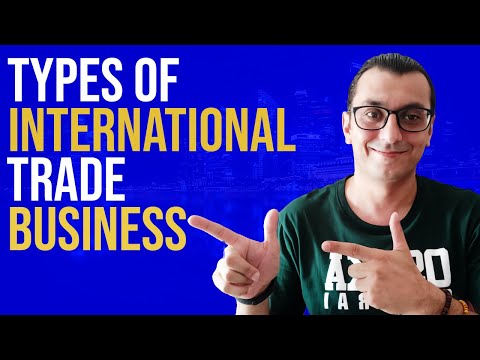TYPES OF INTERNATIONAL TRADE BUSINESS - How To Start Import Export Business From Scratch (Part-4)

Hey, What’s up, everybody. Welcome in thanks for being here today. We are going to continue our series about how to start an import-export business from scratch, from the very beginning. And today we are talking about types of international trade and business. I think you are going to get some really good ideas.
The possibilities are truly endless when it comes to building your business and be your own boss. I strongly advise you to watch other parts of the series, you can find the link in the description. The free, fair, and reciprocal exchange of goods and services between two different countries is largely referred to as international trade. It involves the export and import of products that are meant to fulfill a certain need, meet existing demands, or act as a legitimate way to diversify a country’s economic basket. The need to conduct global trade primarily arises from the uneven distribution of natural resources.
This leads to a division of labor, development of technical know-how, and lowering of comparative cost, thus making some countries more suitably placed to produce certain goods or services. A smooth flow of international trade ensures that the world economy continues to thrive despite political, social, and cultural differences. In the last few decades, the international trade scenario has expanded its reach by leaps and bounds. This is why, for anyone willing to make a career in the field of international trade and finance, gaining a detailed understanding of the basic types of global trade becomes extremely crucial.
Hey, My name is Murat, here to help you start or grow your import-export business, make more money, save more time, and help more people too. And I'm excited for you because there's a lot of opportunities to import or export products anywhere in the world. The comments in this video are based on my own experiences of growing our international trade and businesses, which led to our companies growing year by year.
It's this success that inspired me to develop my youtube channel. So, there are comments from the trenches, from people who have created and grown B2B export sales. Now, before I dive into this, I have a bold request from you.
One; Please give a thumbs up to this video here on youtube that helps the youtube algorithm boost this video and reach more people. And number two; Please do not forget to subscribe to my channel and hit the bell for more great quality content on how to build your own international trade business and make more money. Ready? Let's dive in. Here's what to expect in this video.
Export Business What is an export business? Types of exporting What are the pros and cons of exporting? Import Business What is an import business? Objectives of import trade Important steps involved in typical import transactions Entrepot Trade What is an entrepot trade? The reasons why most countries deal in entrepot trade Let’s get started. What is an Export Business? Export business is the shipping of domestic goods or services to a foreign country, where the products will be processed, used, sold, or re-exported. What is the definition of Export? Exports, along with imports, are a key element in a country’s trade balance as the sale of exported goods increases a nation’s gross output. Many countries encourage export as a way to increase employment, disposable income, and consumer spending. Furthermore, the more products a country exports, the greater the competitive advantage as it gains expertise in producing goods and services that foreign countries want to use.
On the upside, exports increase a nation’s foreign exchange reserves, allowing the central bank to defend the domestic currency and stabilize its value while lowering the cost of exports to foreign countries. On the other hand, exporting countries use trade protectionism measures such as tariffs, quotas, and subsidies, to protect their industries and manufacturers and give them a competitive advantage. In this context, the government policy, and the exchange rates are very important factors that affect a country’s exports.
Let’s look at an example. Businesses that seek to expand globally should pay attention to currency fluctuations. Currency risk is one of the reasons that an expansion strategy may fail, especially when a company is mostly dealing with overseas buyers. For example, company A is a German car manufacturer, and it exports auto parts to Turkey.
If the euro is strong against the Turkish lira, it takes fewer euros to export the auto parts to Turkey. Conversely, if the euro is weak against the Turkish lira, it strengthens the power of the Turkish importer. To deal with currency risk, the German car manufacturer should insist that all deals with Turkish partners are made in Euro. On the downside, this may deter Turkish importers from partnering with the German exporter, preferring to do business in their local currency. Types of Exporting Exporting mainly be of two types: Direct exporting and indirect exporting. Direct exporting: Direct exporting means the sale of goods abroad without involving middlemen.
In the case of direct exporting a firm itself undertakes to sell its products overseas and is responsible for dealing with foreign customers directly. A company may carry on direct exporting by any one of the following modes: By establishing the company’s corporate export provision. By appointing foreign sales representatives and agents. Through foreign-based distributors and retailers.
Through foreign-based state trading corporation. Through overseas sales branches. Indirect Exporting: Indirect exporting means the sale of goods abroad through middlemen. Indirect exporting involves using the help of independent middlemen and sales intermediaries that take the responsibility of sending the products to foreign countries. Some major types of intermediaries of indirect exporting are: Commission agents.
Domestic-based export merchants or export trade companies. Buying or purchasing agents. Export agents. EMCs (Export Management Companies) And, Cooperative organizations. There are two types of indirect exporting: Occasional (Passive) Exporting, Active Exporting.
Occasional (Passive) exporting takes place when company exports from time to time either on its own initiative or in response to unsolicited orders from abroad. And Active exporting takes place when the company commits to expand its exports to a particular market. For example, we have two companies, one of our companies is SOLAR SOLENTURK which is exporting solar street lights. Sometimes we received orders from middlemen for various countries which we didn’t export our products before. And we can sell the solar street light that countries with middlemen and we earn together. That is the example of passive exporting.
On the other hand, we have another company which is FUTURESIA Global Trade. We are serving our clients or partners to expand their exports to Turkish and South East Asian markets (especially Thailand and Malaysia). So in this term, we become middlemen and our clients or partners start to do active exporting with us. Advantages of indirect exporting over direct exporting: One - Indirect exporting involves less investment.
The manufacturer does not have to develop an export department, an overseas sales force, or a set of foreign contracts. And number two - Indirect exporting involves less risk. Because international trade marketing intermediaries bring know-how and services to the relationship, the seller will normally make fewer mistakes.
Benefits of Exporting: Increased Competitiveness: Exporting can allow you to gain exposure to new ideas, management practices, marketing techniques, and ways of competing which can help you to better position your business both within the local and overseas markets to increase competitiveness. Increased Sales: Exporting is one way of increasing your sales potential. Given the small size of most local markets, exporting allows a company to expand its market beyond the scope of a limited and increasingly saturated national market.
For instance, a producer in Trinidad and Tobago has access to a market of just over one point five million people. However, exporting to Brazil for example expands that producer’s potential market to close to two hundred million people. With an expanded market, exporting can pave the way for increased sales and expansion.
Higher Profits: No company would export unless it intends to make a profit. Generally speaking, overseas customers in larger markets are likely to place much larger orders than a local buyer. Some rare products (such as certain specialty foods) may also be able to command a higher price in an overseas market. Particularly in a market where the consumer is relatively affluent and willing to pay a premium price for a premium product. All these factors can positively affect the profit margins of a company.
Lower Costs: By expanding internationally beyond the domestic market, sales will increase and therefore production levels will also increase. As production levels rise, the costs per product are typically reduced depending on the manufacturing process. Reduced Vulnerability: When you export, then your firm is no longer solely dependent on sales within the local market. Therefore, if economic conditions become unfavorable domestically, the impact on your operations might not be as huge if you have been able to expand your business to foreign markets. It is also advisable that you don’t become dependent on a single export market as this too can make you too vulnerable to fluctuations in that market. Extending the Product Life Cycle: In the domestic market, your product might be approaching the end of its life cycle.
In such an instance, finding an export market would be ideal to extend the life cycle of the product. Follow your Customer Abroad: For example; Outward migration from Turkey to Europe and North America, in particular, is fairly high. This has led to the creation of a sizeable Turkish diaspora abroad with Turkish ‘taste’ and a desire for authentically Turkish products.
You can take advantage of this situation by targeting the diasporic market to drive your export sales. Product Modification To meet safety, security, and other requirements in the export market, your product may have to be modified. Some companies may not have the technical know-how where these modifications are concerned and might have to incur the costs associated with hiring an expert. Having to modify your product for the export market can also stretch the human and other operational resources of the company. Payment: Apart from the risk of non-payment, the complicated process involved in the collection of payments using various methods (consignment, letter of credit, and etc.) can be consuming. Companies with limited cash-flow, therefore, need to fully understand the financial pitfalls associated with exporting.
Financial Risks: Economic or government restrictions in the export market could negatively impact your business. Exchange rate fluctuations could also prove to be problematic. Transportation Risks: In exporting your product, there is the risk of damage, loss, or theft. Commitment: Without a high level of commitment, it is highly unlikely that your export venture would succeed in the long term.
Maintaining a sustained presence in the export market requires time, willingness, and substantial resources. It can also take months or even years before your decision to export begins to reap dividends. These are all issues that the potential exporter must bear in mind. Cultural Differences: The language, business practices, and other customs in the export market may be different from your domestic market. To achieve greater success in the export market, you need to become familiar with the cultural situation in your export market and adjust your approach to suit if required.
Market Information: Finding information on some markets can be extremely difficult. Lack of information would mean that you don’t have sufficient information on your competitors and the trends related to your specific product and similar products. This can negatively affect your ability to do well in the target market.
Import Business What is an Import Business? Imports are foreign goods and services bought by citizens, businesses, and the government of another country. It doesn’t matter what the imports are or how they are sent. They can be shipped, sent by email, or even hand-carried in personal luggage on a plane.
If they are produced in a foreign country and sold to domestic residents, they are imports. What is the definition of Import? The import trade is referred to goods and services purchased into one nation from another. The word “import” originates from the word “port” because the products are frequently transported via ship to foreign countries.
Similar to exports, imports are also the backbone of international trade. Here, if the expense of a country’s imports is more than the value of its exports then the country has a negative balance of trade (BOT), which is also known as a trade deficit. Every country imports goods and services that the domestic country cannot manufacture, maybe because the country cannot produce effectively or cheaply like another exporting country.
Few countries sometimes also import commodities and raw materials which are not available on their premises. For instance, many nations import oil they cannot manufacture it locally or cannot provide sufficient to meet the demand. Objectives of Import Trade To Speed Up Industrialisation: Developing countries import scarce raw materials, capital goods, and advanced technology required for rapid industrial development. To Meet Domestic Demand: The goods which are in demand but are not available in the country are imported.
To Overcome Natural Disasters: During drought, flood, earthquake, and other natural calamities, countries import food grains and other essential commodities to prevent starvation. To Improve Standard of Living: Imports enable consumers in the home country to enjoy a wide variety of products of high quality. It helps in improving the standard of living of the masses. To Ensure National Defence: The importer must get the receipt of credit from his concerned bank and send it to the foreign supplier.
Important Steps Involved in a Typical Import Transaction: One – Trade Enquiry and Sending Quotations The domestic buyer who wishes to buy the goods from the other country sends an inquiry relating to price, desired quality, terms, and conditions for the export of goods. The exporter sends a reply to the inquiry in the form of ‘Quotation’. The quotation is also known as ‘Proforma Invoice’ which contains information about the selling price, quantity, quality, mode of delivery, etc. Two – Procurement of Import License Goods can be imported only upon the license, the importer requires to obtain an import license. Three – Obtaining Foreign Exchange The overseas supplier asks for payment in a foreign currency. Payment requires the exchange of local currency into foreign currency.
Four – Placing Order or Indent After the receipt of the ‘Quotation’, if the prospective buyer finds the information suitable to him, he places the ‘Order’ for the import of goods. The importer must get the receipt of credit from his concerned bank and send it to the foreign supplier. The importer makes the finance settlements in advance to remunerate to the exporter when the shipment arrives at the destination. Five – Receipt of Shipment Advice After storing the consignment on the ship, the foreign supplier sends the shipment advice to the importer. The shipment advice includes data about the shipment of products such as: Invoice number The landing or airways bill date and number Name of the ship with date Port or Destination of export Classification of goods and quantity Date of the sailing of the vessel. Six – Arrival of Goods The overseas supplier dispatches the Goods as per the contract.
Seven – Customs Clearance and Release of Goods All the imported goods have to have a clearance from customs after they pass the borders. When the ship arrives at the port, the importer has to obtain a delivery order/endorsement for delivery on the back of the bill of lading from the concerned shipping company. Entrepot Trade What is an Entrepot Trade? Entrepot trade, in simple terms, is a specific form of international trade that comprises both – import and export trade. Under this type, goods and services are imported from one country so that they can further be exported to another country. This is to say that the imported goods are not used for consumption or sale in the importing country.
Instead, the importing country just adds some value to the goods before exporting them yet again. For example, if Turkey imports rubber from Thailand, processes it, and re-exports it to another country like Germany, it would be referred to as Entrepot trade. Most countries deal in Entrepot trade because of the following reasons: One - Lack of access or direct connection between any two countries. Two - Better processing or logistical facilities available in a third country.
Three - Absence of a trade agreement between two countries. Four - No trade finance in banking facilities available in the importing country. Congratulations! You have officially learned Types of International Trade and Business. Now start booming and make the world your business! Also, if you would like to learn more about international trade, you can watch my other videos here on my youtube channel.
Now, I want to make sure you get this and prove it to me. I want you to do a couple of things for me. One; hook me with a thumbs up.
And number two; comment below with an I get it. I just really want to make sure you understand these types of international trade and business, because they are gaining a detailed understanding of the basic types of global trade becomes extremely crucial for anyone willing to make a career in the field of international trade and finance. So comment below with I get it. Use the hashtag #TeamMurat if you are a part of Team Murat. And subscribe to my channel here. So go out there and make some trade, be confident, and realize that you can sell and serve at the same time.
So yes, make sure you catch some of the other videos over here. We got some good stuff coming your way, so make sure you subscribe below, but also right here. Thanks again, click over here to keep going. Bye.
2021-03-21 20:41


